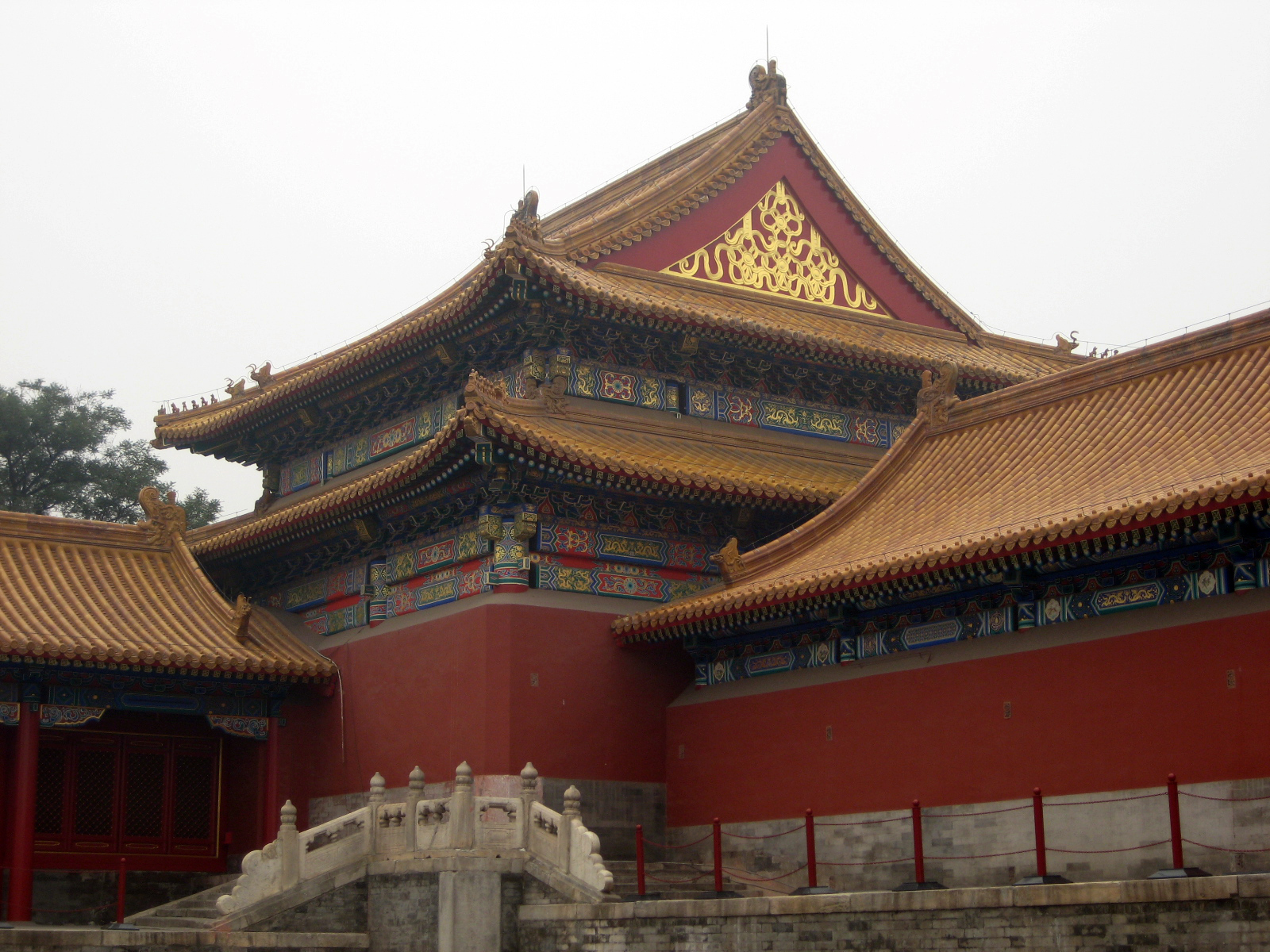 All we heard about was the traffic jams, the crowded millions of people and the pollution. We were expecting a chaotic city on par with Bangkok. Au contraire!!! The city is modern and impeccably clean. They clean the dead leaves from the trees! The airport is bright, new, orderly and very friendly. They even have an electronic survey at the customs window so you can grade your customs agent as they are inspecting your passport and documents. The highways are new, the tollbooths are built in imperial style architecture. It’s all a great touch.
All we heard about was the traffic jams, the crowded millions of people and the pollution. We were expecting a chaotic city on par with Bangkok. Au contraire!!! The city is modern and impeccably clean. They clean the dead leaves from the trees! The airport is bright, new, orderly and very friendly. They even have an electronic survey at the customs window so you can grade your customs agent as they are inspecting your passport and documents. The highways are new, the tollbooths are built in imperial style architecture. It’s all a great touch.
A couple of years ago we would have been able to see the rooftops of the forbidden city from our hotel window, but new high rise buildings are now devouring the sky. The old city of small hutong alleys is now giving way to a modern metropolis. It’s both exciting and a little sad. With the exception of the imperial monuments, the old city will soon be lost forever.
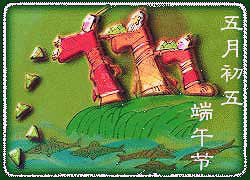 We arrived June 19th, the first day of the Duan Wu festival. It’s kind of like the Chinese version of the summer solstice organized around the 2500 year old Dragon boat races and the celebration of the Chinese patriot poet, Qu Yuan, who in protest of imperial corruption, tied a big rock around his neck and jumped into the Miluo river.
We arrived June 19th, the first day of the Duan Wu festival. It’s kind of like the Chinese version of the summer solstice organized around the 2500 year old Dragon boat races and the celebration of the Chinese patriot poet, Qu Yuan, who in protest of imperial corruption, tied a big rock around his neck and jumped into the Miluo river.
The local villagers beat on drums and splashed the water with boat paddles, attempting to save him from the man eating fish and evil spirits. They even threw rice into the water hoping the fish would rather eat rice than Qu Yuan, but everything came to a halt with the appearance of a huge river dragon. As the story goes, Qu Yuan asked the villagers to wrap the rice into three-cornered silk packages to ward off the dragon. I still don’t know if he said this to them as he was going under or appeared to them later on as an apparition, but nonetheless, these 3 corner rice packets, now known as zongzi (sticky sweet rice wrapped in leaves) have been a traditional food for this holiday ever since.
Our San Francisco neighbor, Jackie told us to look up her cousin Stuart in Beijing. He works and lives here with his wife, Carmen and two small children. We don’t really like to impose on people when we travel but Carmen sent us an email and an invite and we were curious to see what it was like for foreigners to live here. They brought us to the Chang Pu He Garden restaurant (a really good restaurant) near our hotel. As it turned out, Stuart and I not only attended the same university, we also lived in New Orleans at the same time. His ex-girlfriend worked at my jazz club. And so we spent the next 2 hours reminiscing down memory lane, learning what to see and where to go and eating a phenomenal meal of peking duck, sweet tofu, grilled asparagus with candied nuts, fermented chicken, braised pork, sweet rice, steam rice, bitter rice, fruit, beer, some strange dishes that I could never explain, and of course, zongzi.
 Our first adventure started out with a walk through the Exquisite Park, and old park that winds into Tiananmen Square. Before the 1901 Boxer rebellion, a smaller Tiananmen Square was filled with foreign offices. Although the Boxers lost the rebellion, they did manage to burn down most of the foreign offices in the attempt to force the devils out of the country. By the time of Mao’s 1949 People’s Republic, the Square quadrupled in size and became the center of the communist pride; parades, tanks and a capacity to hold over a million people. When Mao died in 1976, even he became a part of the square. We wanted to visit the Mausoleum of Mao (which we refer to as the Maosoleum) but it was being restored. A lot of the monuments are being restored in preparation for the 2008 Olympics. Mao wanted to be cremated, when he died, but the Party officials thought “the great helmsman” would be better off embalmed, kind of like what the Soviets did to Lenin. However, because of the Sino-Soviet split, they couldn’t get the secret embalming sauce from Russia. They went to the Vietnamese, who learned the trade from the Russians when they embalmed Ho Chi Min in 1969. Since we never got into the Maosoleum, we really can’t say for certain, but we’ve been told his skin has a very waxy appearance and visitors are rushed past the “crystal coffin” so quickly, they’re not quite sure if it’s the real body or something created by Madam Tussauds.
Our first adventure started out with a walk through the Exquisite Park, and old park that winds into Tiananmen Square. Before the 1901 Boxer rebellion, a smaller Tiananmen Square was filled with foreign offices. Although the Boxers lost the rebellion, they did manage to burn down most of the foreign offices in the attempt to force the devils out of the country. By the time of Mao’s 1949 People’s Republic, the Square quadrupled in size and became the center of the communist pride; parades, tanks and a capacity to hold over a million people. When Mao died in 1976, even he became a part of the square. We wanted to visit the Mausoleum of Mao (which we refer to as the Maosoleum) but it was being restored. A lot of the monuments are being restored in preparation for the 2008 Olympics. Mao wanted to be cremated, when he died, but the Party officials thought “the great helmsman” would be better off embalmed, kind of like what the Soviets did to Lenin. However, because of the Sino-Soviet split, they couldn’t get the secret embalming sauce from Russia. They went to the Vietnamese, who learned the trade from the Russians when they embalmed Ho Chi Min in 1969. Since we never got into the Maosoleum, we really can’t say for certain, but we’ve been told his skin has a very waxy appearance and visitors are rushed past the “crystal coffin” so quickly, they’re not quite sure if it’s the real body or something created by Madam Tussauds.
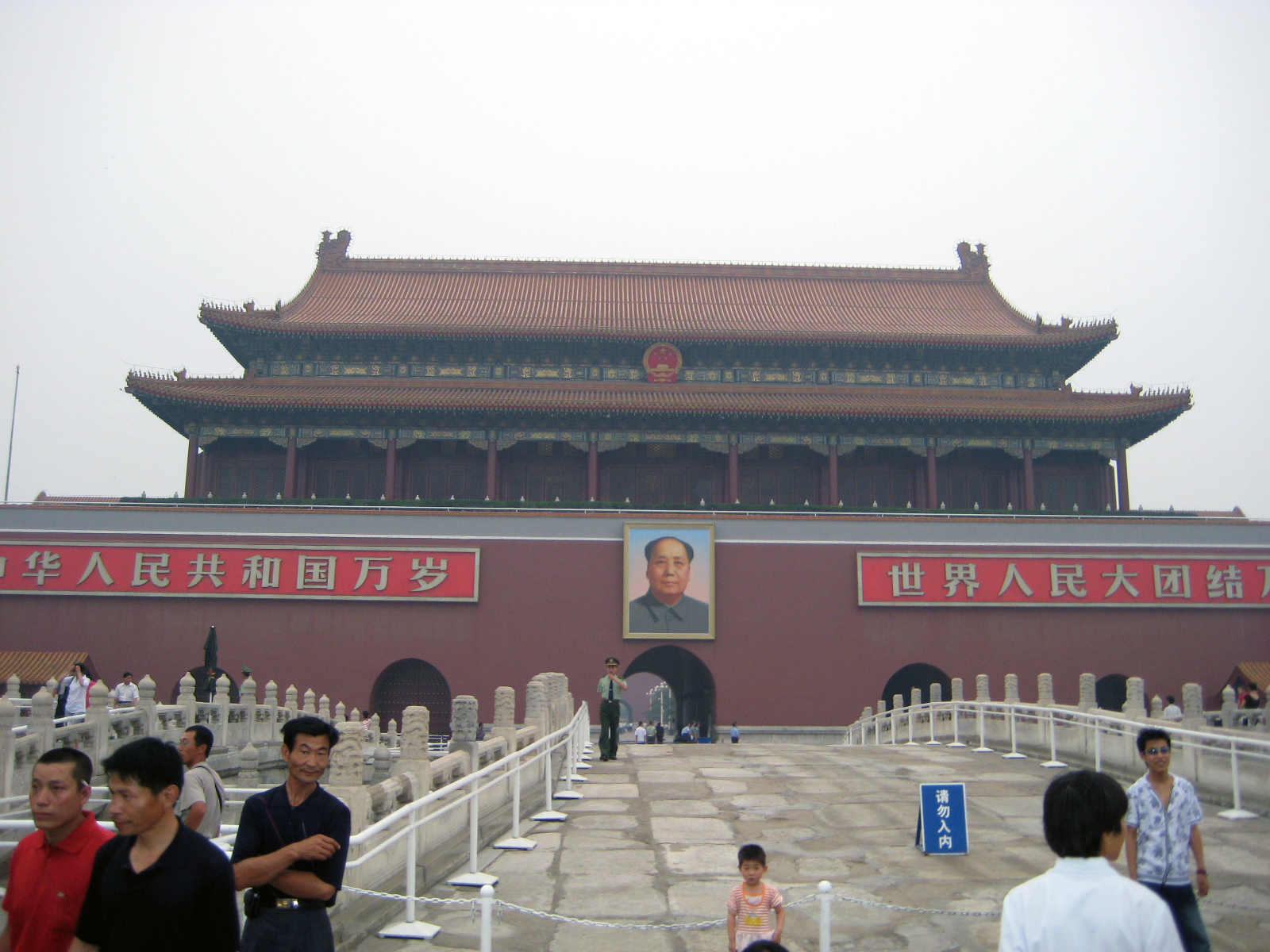 The Tian’anmen gate leading into the Forbidden City is overstated with the now famous portrait of Mao. The gate, also known as “The Gate of Heavenly Peace”, is at a most important spiritual position in the city. There are many who believe that Mao’s portrait is an insult to the balance of good harmony. Mao could care less.
The Tian’anmen gate leading into the Forbidden City is overstated with the now famous portrait of Mao. The gate, also known as “The Gate of Heavenly Peace”, is at a most important spiritual position in the city. There are many who believe that Mao’s portrait is an insult to the balance of good harmony. Mao could care less.
To say “The Forbidden City is enormous” is like saying King Kong is a big monkey. This place is Brobdingnagian. It covers over 1,000,000 square meters and has 9,999 rooms. It could be the largest imperial palace in the world. The heavy mist over the city made it even more impressive, as if the city was coming out of the dragon’s breath. In fact, in the time of the emperors, smoke pots were lit to enhance the mystical enigma of the city. Built between 1406-1420, the Ming Dynasty used an estimated 200,000 workers for the construction. It makes us wonder, was it built to keep people out or to keep people in?
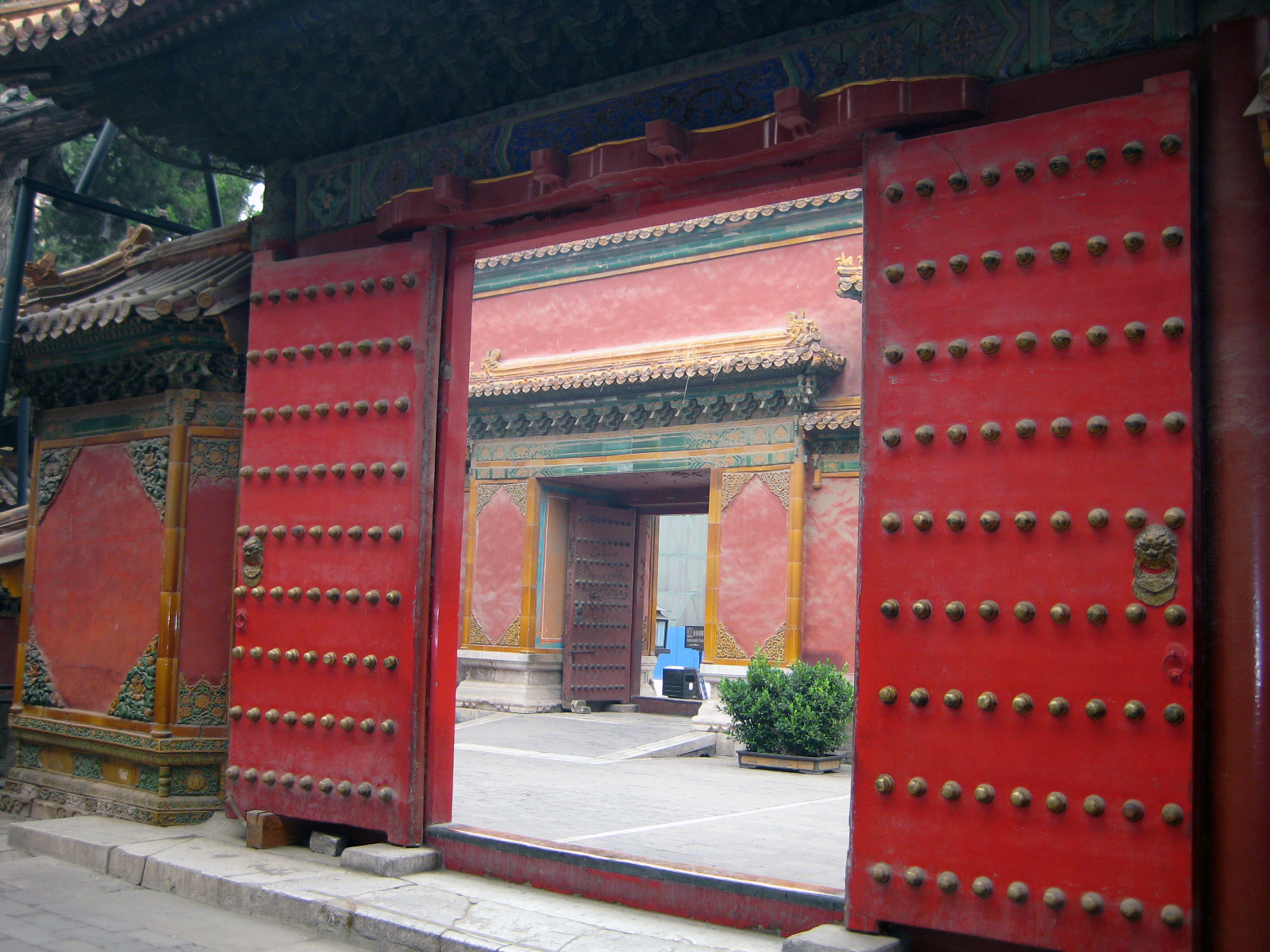 The Daoist principles of Yin and Yang are represented in all of the architecture. Odd numbers like 3,5 ,7 and 9 represent Yang (male). The number 9 is reserved for the emperor. The combination of 9×9 is very auspicious and all the doors for imperial use have 81 brass studs in the pattern.
The Daoist principles of Yin and Yang are represented in all of the architecture. Odd numbers like 3,5 ,7 and 9 represent Yang (male). The number 9 is reserved for the emperor. The combination of 9×9 is very auspicious and all the doors for imperial use have 81 brass studs in the pattern.
After 24 emperors covering close to 500 years, the Forbidden City ended it’s influence over China in 1912 when Puyi, the last emperor abdicated the throne at the age of 18. During the struggle before the Communists took over in 1949, the Forbidden City was stripped of most of the valuable wealth. The large bronze vats that once contained water to put out fires were also once covered with gold leaf. They’re not anymore. You can still see scratches on the outside of the vats were people tried to claw off the gold.
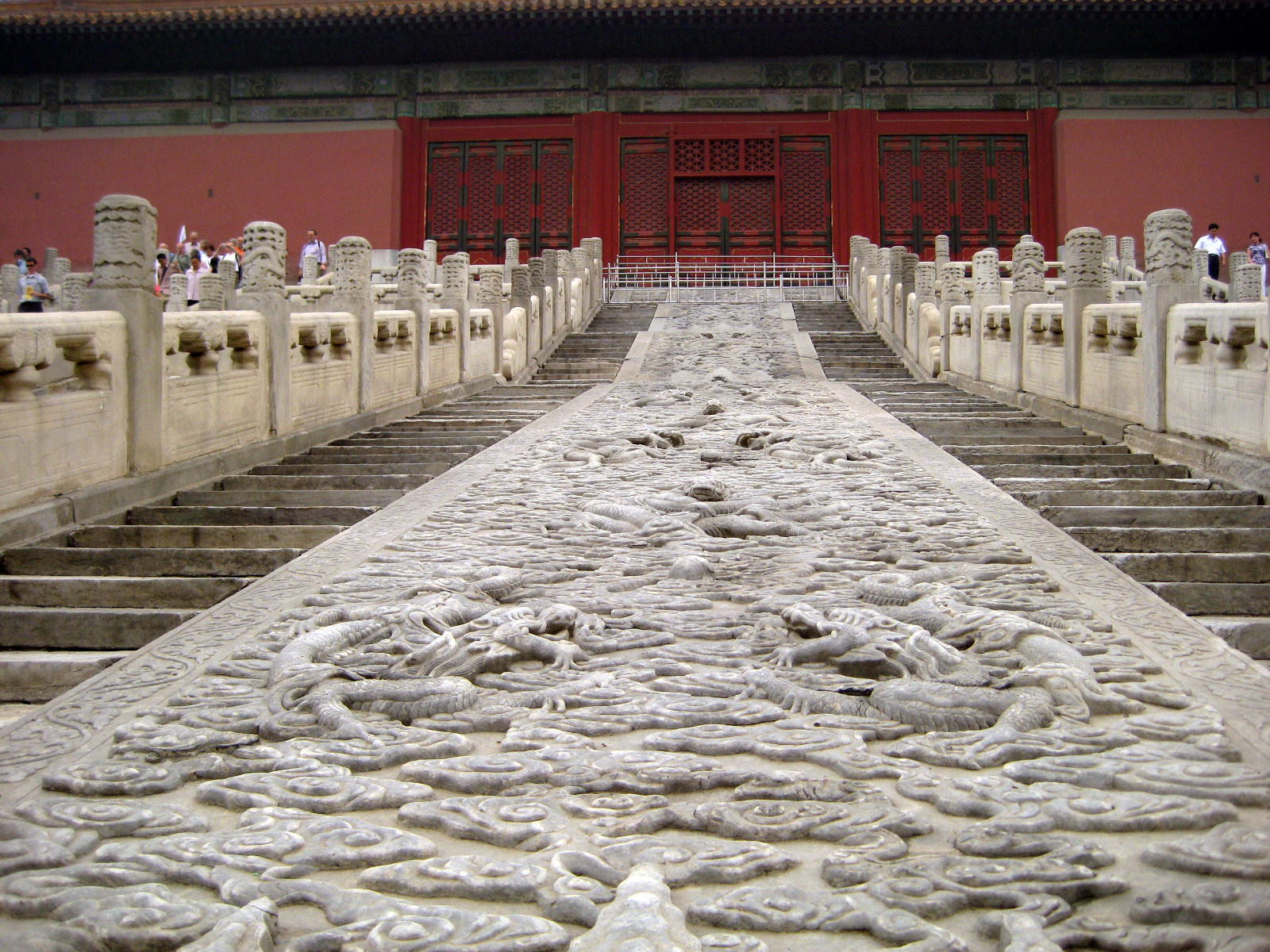 Long carved marble walkways reserved for only the Emperor’s feet are set into the center of the steps to every imperial hall in the city. These are massive carved pieces mined from a nearby quarry. One of them is over 3 meters wide and almost 17 meters long. It weighs 200 tons and was carved from one piece of rock. In order to transport the larger pieces, like this one, wells were dug along the way from the quarry to the Forbidden City. Water from the wells was poured on the road in deep winter and when the ice was strong enough, the stones were dragged to their current location. What a feat of engineering.
Long carved marble walkways reserved for only the Emperor’s feet are set into the center of the steps to every imperial hall in the city. These are massive carved pieces mined from a nearby quarry. One of them is over 3 meters wide and almost 17 meters long. It weighs 200 tons and was carved from one piece of rock. In order to transport the larger pieces, like this one, wells were dug along the way from the quarry to the Forbidden City. Water from the wells was poured on the road in deep winter and when the ice was strong enough, the stones were dragged to their current location. What a feat of engineering.
By the way, the audio guides here are the coolest thing we’ve seen in audio guide technology. It’s radio controlled so that as soon as you come into the vicinity of one of the attractions, it’s activated from the radio sensor. No numbers to push, no buttons, no problems. Just listen.
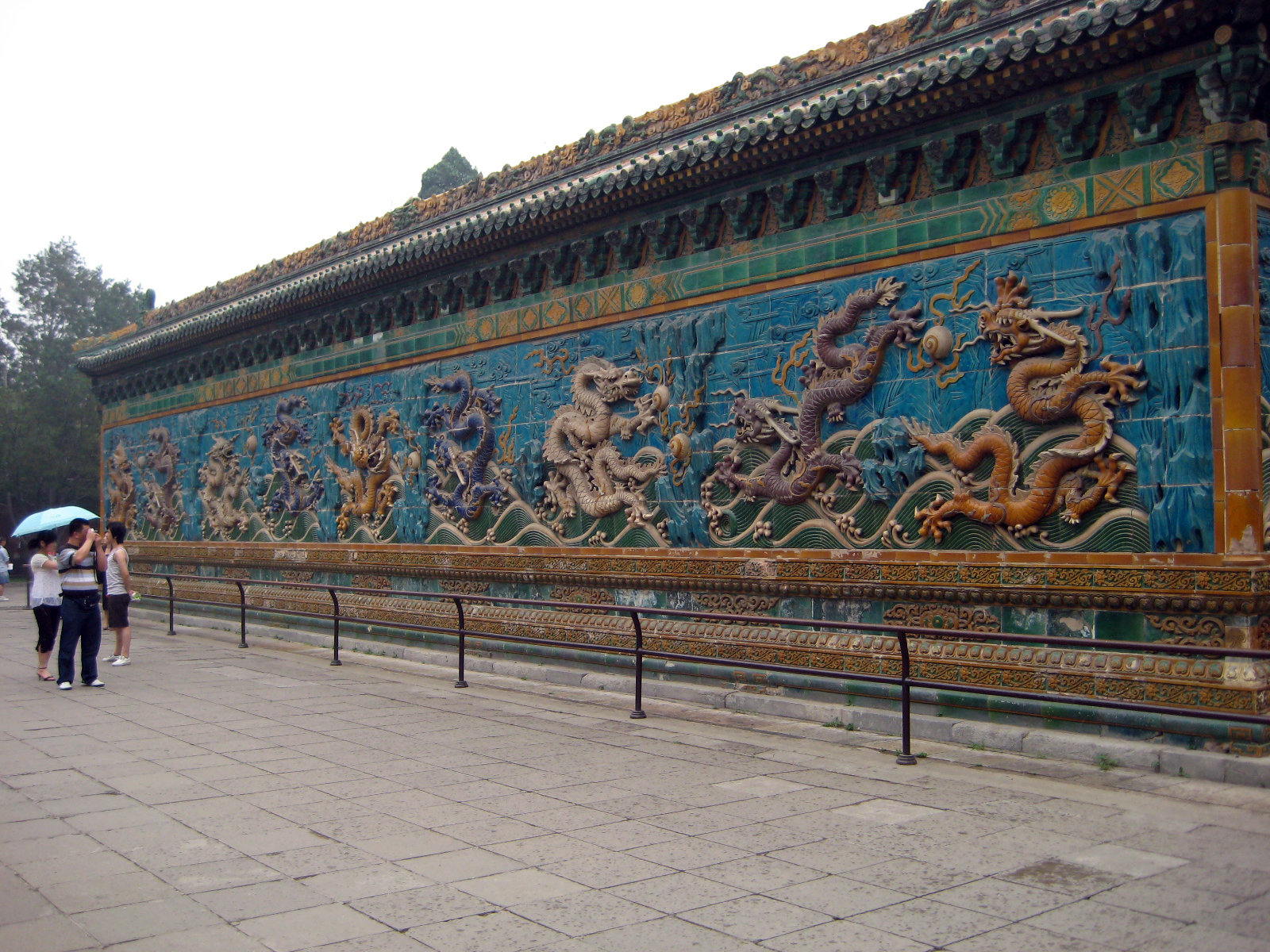 We left the Forbidden City and continued north to the old Imperial park of Bei Hai. Opened to the public in 1924, it’s still manicured to perfection; beautiful lawns, tranquil views of the lake and restful pavilions along the Imperial pathway. The masterpiece of the park is the 18th century 9 dragon screen. This 86’ (26 m) long double sided wall shows the 9 dragons playing with pearls against a background of the sea and clouds. The screen was put in this location because it blocks the straight route north from the Gate of Imperial Zenith to the south Gate of Peaceful Longetivity. Chinese ghosts can only travel in straight lines and once they hit the wall, that was as far as they could go. Chinese ghosts, apparently, can not travel through walls. They’re also not smart enough to just go over it.
We left the Forbidden City and continued north to the old Imperial park of Bei Hai. Opened to the public in 1924, it’s still manicured to perfection; beautiful lawns, tranquil views of the lake and restful pavilions along the Imperial pathway. The masterpiece of the park is the 18th century 9 dragon screen. This 86’ (26 m) long double sided wall shows the 9 dragons playing with pearls against a background of the sea and clouds. The screen was put in this location because it blocks the straight route north from the Gate of Imperial Zenith to the south Gate of Peaceful Longetivity. Chinese ghosts can only travel in straight lines and once they hit the wall, that was as far as they could go. Chinese ghosts, apparently, can not travel through walls. They’re also not smart enough to just go over it.
North of Bei Hai is Hou Hai lake. We were told by Stuart and Carmen to check out the restaurants and bars along Lotus Lane (which sounds like a Chinese porn star). But sure enough, anchored by a Starbucks café, there is a run of at least 25 very contemporary restaurants with outdoor seating over the lotus gardens along the lake. We sat under an umbrella, protected from the rain and enjoyed a great lunch of something that tasted like fried calamari, and pancakes made of sticky rice and sweet chopped pork. Normally we have a rule about ordering from menus with pictures of the dishes, but we’ve put the rule aside while we’re in China. The photos were really helpful here to let us know which dish was the fried worms. We also tasted our first yangjing beer, the local brewery. From 1122-256 BC, during the Zhou Dynasty, Beijing was known as Yanjing. All that’s left of the 3000 year old name is the beer.
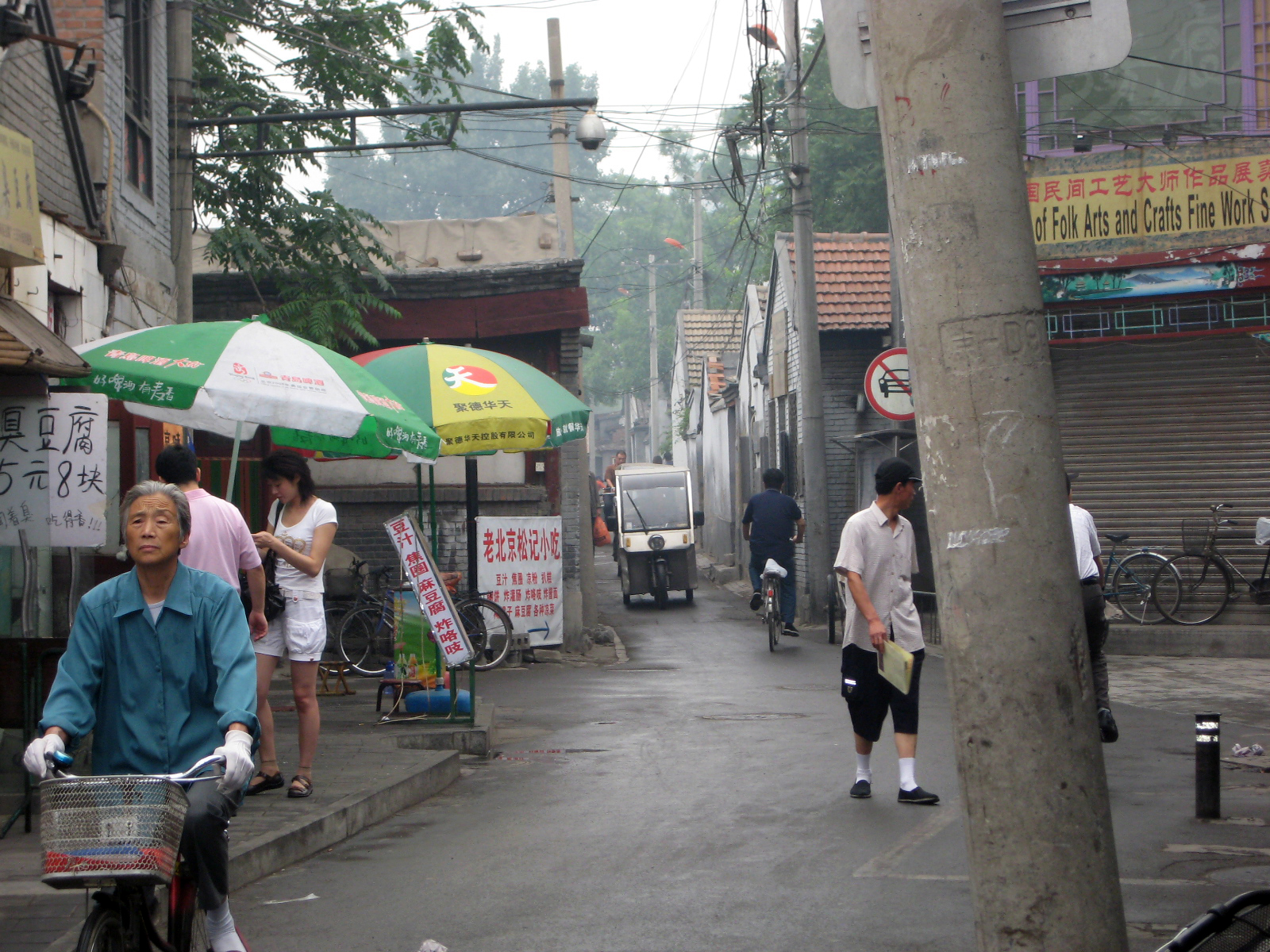 After lunch we headed north and east to visit the Lama Temple or Junghe gong (rhymes with “donkey kong”). By the time we got to the temple, the entrance gates had just closed to visitors, but on the way we got lost in the old hutongs. These single story tile roofed homes built around a central courtyard are connected though a labyrinth of alleyways. You could get lost in them for hours. And we did. They are the last remnants of old Beijing and they’re disappearing quickly. This is where the poor people live. The houses have electricity but no running water. Every 100 meters or so there is a public toilet or bathing facility, which was great for people getting lost in the hutongs and needing a place to pee, like me.
After lunch we headed north and east to visit the Lama Temple or Junghe gong (rhymes with “donkey kong”). By the time we got to the temple, the entrance gates had just closed to visitors, but on the way we got lost in the old hutongs. These single story tile roofed homes built around a central courtyard are connected though a labyrinth of alleyways. You could get lost in them for hours. And we did. They are the last remnants of old Beijing and they’re disappearing quickly. This is where the poor people live. The houses have electricity but no running water. Every 100 meters or so there is a public toilet or bathing facility, which was great for people getting lost in the hutongs and needing a place to pee, like me.
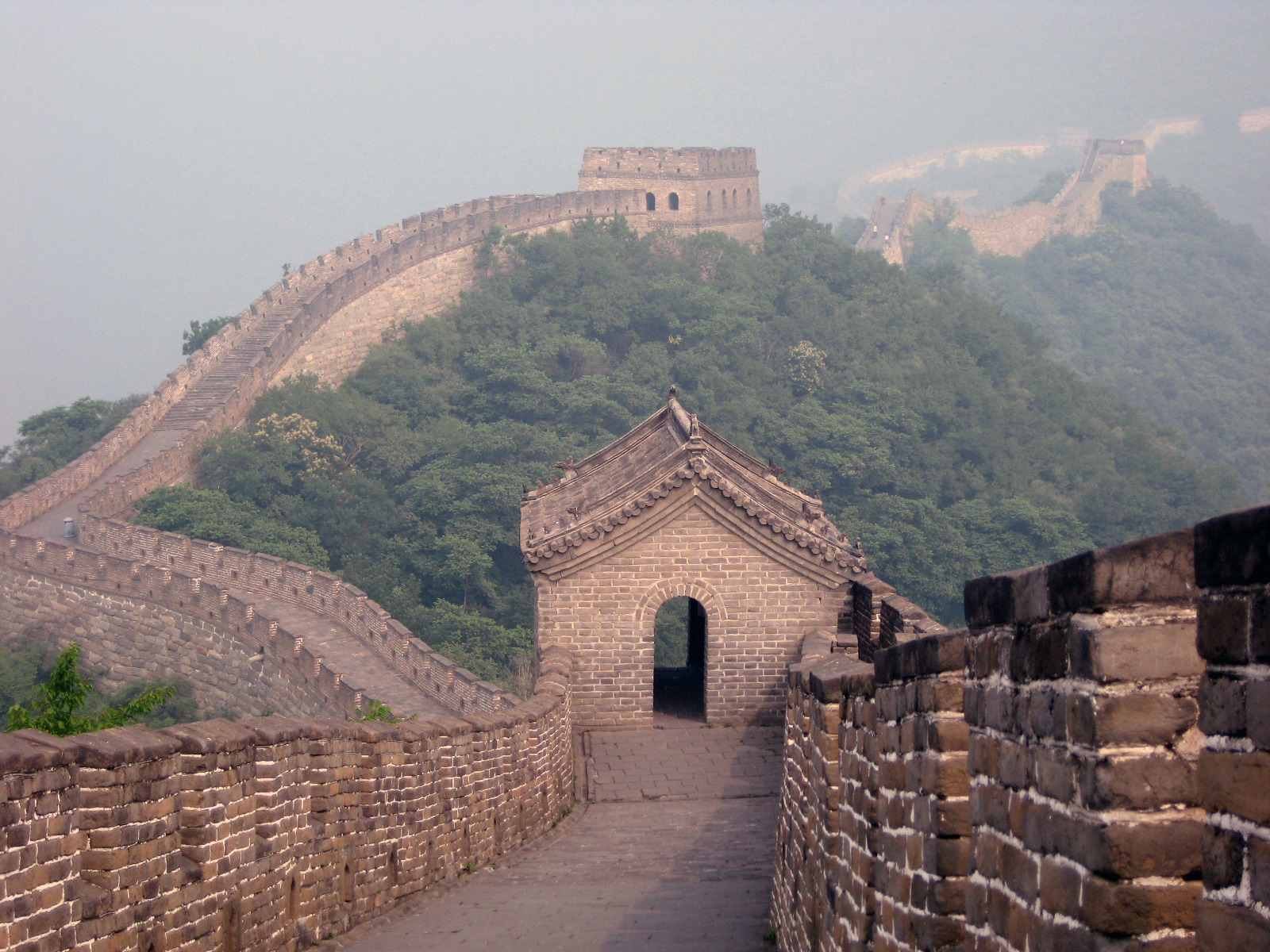 Our visit to the Great Wall
Our visit to the Great Wall
We met our driver at 7:30am. We wanted to get to the wall at Mutianyu before the tourist onslaught and the afternoon heat. Mutianyu is about 70km northeast of Beijing. It’s one of the best-preserved parts of the Great Wall and not as touristy and crowded as the more popular location at Badaling.
The Mutianyu section dates back to the 6th century. Some parts of the wall date back over 2200 years. Qui Shi Huangdi, who gave himself the title of the first emperor of China started this ambitious project. Not only did he build the wall to protect himself from imaginary enemies during his life, he built an enormous army of terracotta soldiers to protect himself from them in the afterlife.
But Qui Shi Huangdi’s hunch about an invasion from the north did prove to be true, albeit a thousand years later when Genghis Khan broke through the wall and conquered northern China. In 1271 Kublai Khan , his grandson, finished the job and established the Yuan Dynasty with it’s capital in Khanbaliq (Beijing).
When the Ming dynasty drove out the Monghols in 1368, they spent the following two hundred years or so rebuilding the walls with granite and brick, adding towers and fortifications. Once they got rid of the Monghols, they were determined to never let them back in.
 For some reason we thought we were going for a nice relaxing ride in the country for a nice relaxing stroll along the wall. This was our second day in China; jet-lag usually kicks in on the second day and it was fierce. We arrived to the wall entrance at 8:30am and it was already 32°C.
For some reason we thought we were going for a nice relaxing ride in the country for a nice relaxing stroll along the wall. This was our second day in China; jet-lag usually kicks in on the second day and it was fierce. We arrived to the wall entrance at 8:30am and it was already 32°C.
Arriving to Mutianyu is like arriving to a base camp for a mountain climb. The base camp village of little shacks climbs up a steep hill up to the cable car house. You have to walk very fast to get by the vendors. They’re on you like bears on honey, hawking tee shirts, folk toys, masks, jewelry, soft drinks, water, beer and strange dried energy food that looked like petrified bees and thistle.
There is a hiking path up to the top, but we opted for the small cable car that suspended us high over the mountain and valley. After about 5 minutes climbing up over the tree line, there it was, the stone dragon, rising up into the mist.
The humidity covered us like a wetsuit. The temperature was now soaring above 35°C and the walkway was treacherous, undulating up and down the back of the dragon, climbing up and down uneven steps that changed from 3” to 3’. Some of the steps were so steep we had to crabwalk up to the next level. We took brief rests from the sun inside the old sentry towers and then marched on. The combination of fatigue, heat, humidity and jet-lag combined into a very strange sensation of vertigo and we found ourselves holding onto the wall for support. At one point, I looked behind me down the 60° incline of 30 or more steps and realized if I lost my footing, it would be all over.
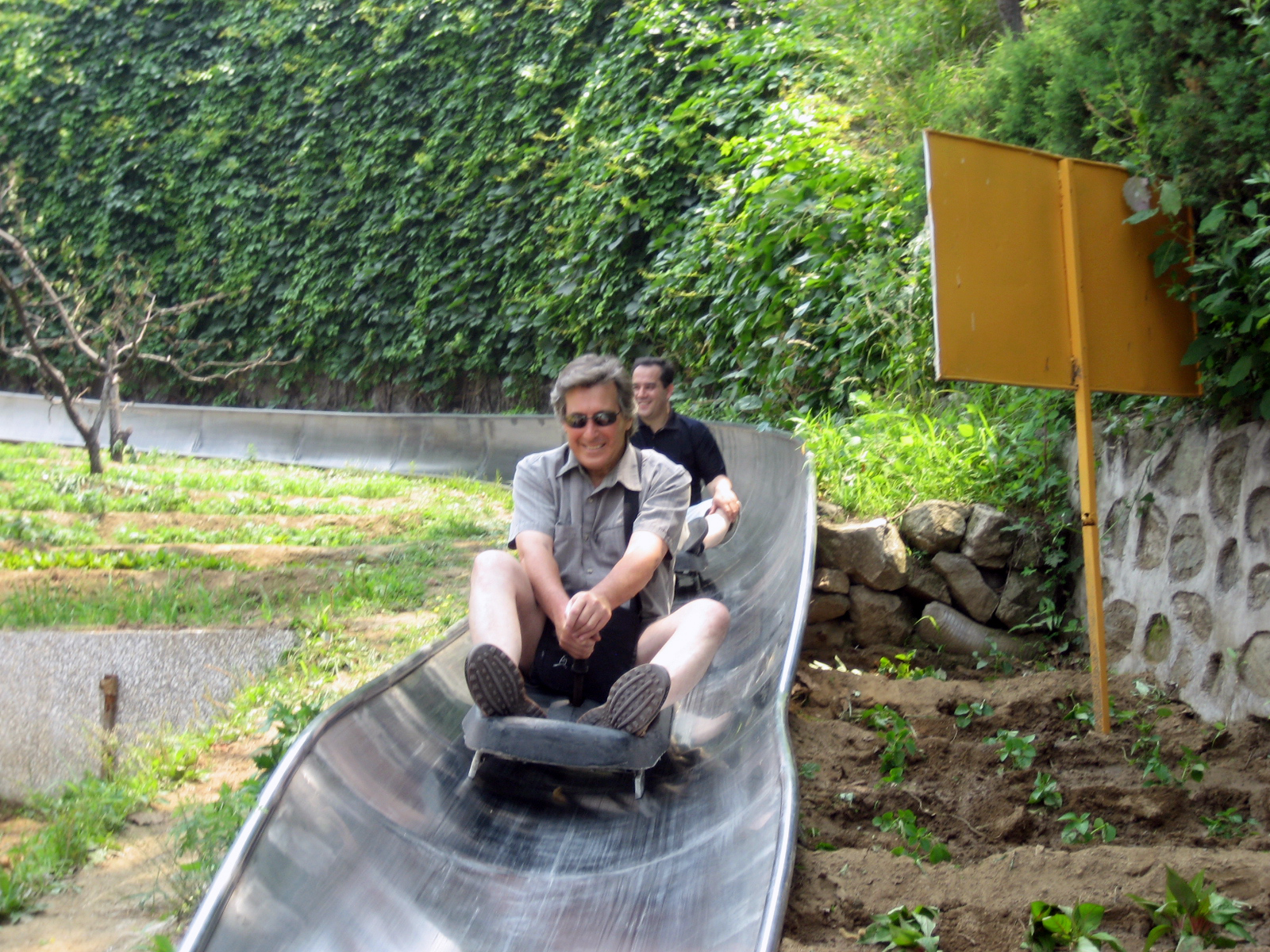 Around a few more bends we saw the aerial chair lifts taking people back down to the base camp. We were so tired and so thirsty but the end was near and with it came a new burst of energy.
Around a few more bends we saw the aerial chair lifts taking people back down to the base camp. We were so tired and so thirsty but the end was near and with it came a new burst of energy.
But somehow we missed the turn off the wall. A group of American women asked us to make a photo of them and before we knew it we had gone another kilometer up the hill.
The final reward of the walk was the ride down. The options were the aerial cable car, the chair lift, hiking down the mountain path or the toboggan. We chose the toboggan. The Chinese are so clever. They built a winding aluminum ramp through the trees and down the mountain.The one person toboggan sleds have a joy stick control; push it forward and the sled goes very fast, pull back on the handle to engage the brake. There were signs and attendants placed at various hairpin turns of the track to make sure you engaged the brake at the proper time. The ride takes about 5 minutes and it’s amazing fun. Some of the people we met along the wall (especially the children) paid to get back up the mountain just so they could have one more ride down the toboggan.
And when it was over, we had to once again maneuver our way through the battlefields of commerce. “Hey, you remember me, I have best price for you.”
I read that in 2003, an international group of geneticists studying Y-chromosome data proved that nearly 8 percent of the men living in the region of the former Mongol empire are descended from Genghis Kahn. The Monghols either loved their captured women or they really liked having children. Genghis’ son Tushi had 40 children. His grandson, Kubilai Khan had 22 legitimate sons, and every year, he added 30 more virgins to his pleasure dome in Xanadu, “where Alph the sacred river ran, ran through caverns measureless to man, down to a sunless sea.”
We didn’t buy anything from the vendors, but we did look at their faces, trying to decide which ones carried the Kahn chromosome.
 Our driver brought us back to the city and dropped us off at the Temple of Heaven, one of the architectural symbols of Beijing and lucky for us, it had just been renovated. The Beijing mist was clearing. The blue roof tiles and bright colors of the Hall of Prayer for Good Harvests made a perfect image against the blue sky.
Our driver brought us back to the city and dropped us off at the Temple of Heaven, one of the architectural symbols of Beijing and lucky for us, it had just been renovated. The Beijing mist was clearing. The blue roof tiles and bright colors of the Hall of Prayer for Good Harvests made a perfect image against the blue sky.
Each winter solstice the Emperor (the son of the heavens) would move from the Forbidden City to the Temple of Heaven complex. Here he would dress in special robes, abstain from meat eating and pray to Heaven for a good harvest. The ceremony had to be perfect; the smallest mistake could mean a bad harvest. In the early days of the Ming Dynasty, a bad harvest was blamed on the emperor, but after a while, the royals got smart and turned the blame on the people producing the event. Times haven’t changed very much.
The ceremony must have lasted a long time. There was the calling of ancestors from the circular mount alter, the walk down the long corridor to the echo wall and into the House of the Heavenly Lord. Then, after changing robes yet again, he was escorted to the Hall of Prayer for Good Harvests. This is the masterpiece of the complex, rising 126’ (38 meters) into the sky with three painted circular rings. The building is 106’ (32m) in diameter and was built without a single nail.
 Through the east gate of the Temple complex we ended up across the street from the Beijing Pearl Market, four floors of unbelievable shopping. The first floor is lenses and electronics (Fauxny, Fauxkia, Fauxtorola, and Crapple iPods. Gretchen bought a Meade 8×24 binocular for around $10. Hey, it does make things look bigger.
Through the east gate of the Temple complex we ended up across the street from the Beijing Pearl Market, four floors of unbelievable shopping. The first floor is lenses and electronics (Fauxny, Fauxkia, Fauxtorola, and Crapple iPods. Gretchen bought a Meade 8×24 binocular for around $10. Hey, it does make things look bigger.
One the second floor you have your designer clothing, shoes and bags; Melvin Klein, Ivan St Laurent, Dolci and Cabana, Roach bags, Fauxregamo shoes and lots more.
The 3rd floor is where the pearls begin and there are some very good bargains as long as you know how to bargin with the sales staff. Price bargaining is the way of life here. We were told to always offer ½ or less and then work your way back up till both parties agree. It’s actually a fun way of doing business. They’ll make jewelry to order as you wait. And, of course, the prices are very low (even without bargaining). The top floors are reserved for the very valuable pieces starting at $2000. The walls up there are festooned with fotos of Bill Clinton, Margaret Thatcher and lots of wealthy, renowned African women we didn’t recognize.
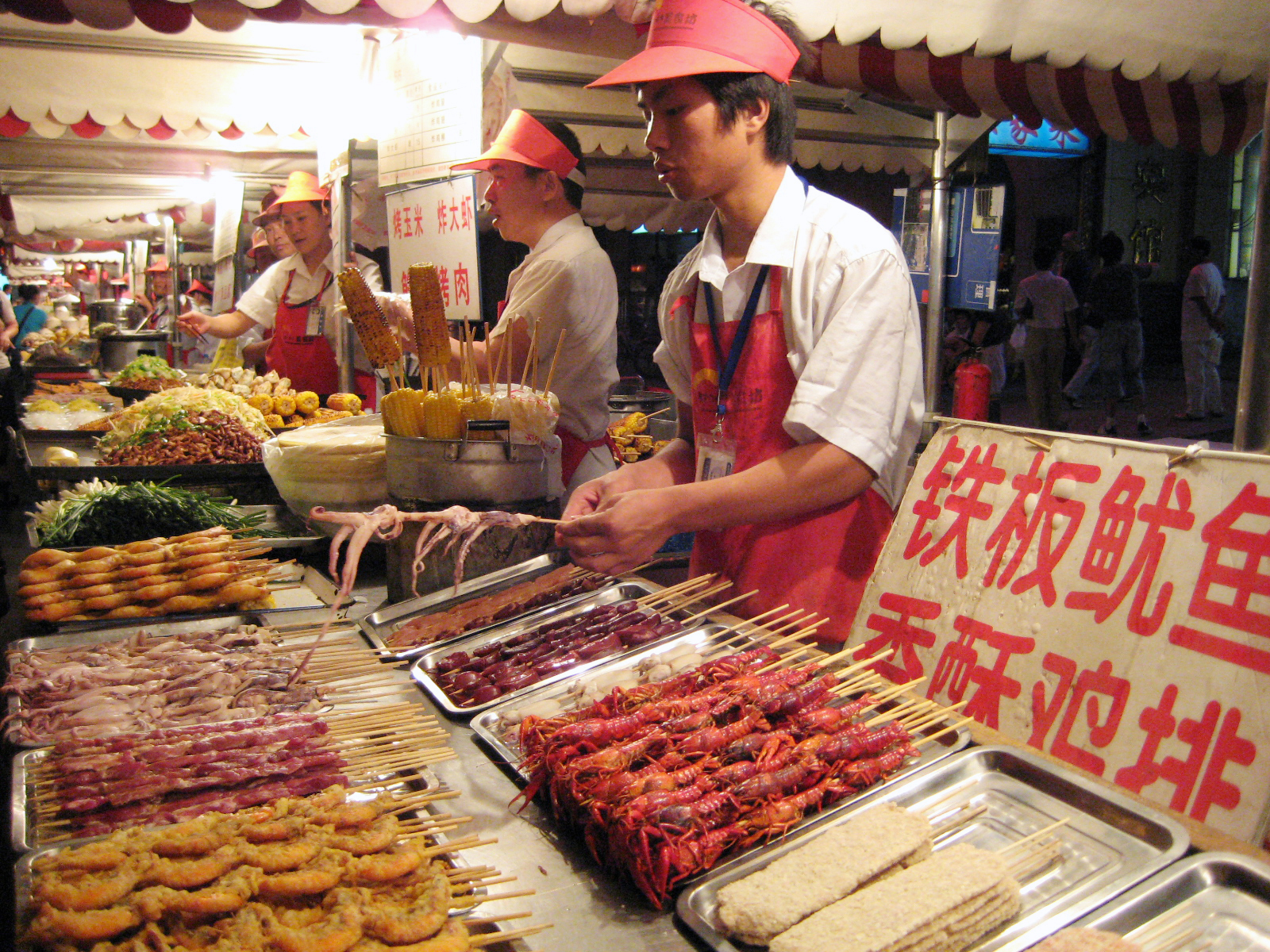 After another long day, we finished up at the night market for a quick snack. This is an old market place that serves food on a stick. I’ve always been a big supporter of food on a stick. America with only popsicles, ice cream bars and corn dogs is way behind the rest of the world. At the night market you have stick food choices of scorpions, centipedes, grasshoppers, beef, pork, squishy tentacled things, eel, worms, bugs, fruit, meatballs and dumplings. You can also get oysters, drinks, coconuts, corn and other strange delights. The prices range from 1 to 15 yuan (12¢ to $2). For some reason, everything we bought was 15 yuan. Maybe they were expecting us to bargain.
After another long day, we finished up at the night market for a quick snack. This is an old market place that serves food on a stick. I’ve always been a big supporter of food on a stick. America with only popsicles, ice cream bars and corn dogs is way behind the rest of the world. At the night market you have stick food choices of scorpions, centipedes, grasshoppers, beef, pork, squishy tentacled things, eel, worms, bugs, fruit, meatballs and dumplings. You can also get oysters, drinks, coconuts, corn and other strange delights. The prices range from 1 to 15 yuan (12¢ to $2). For some reason, everything we bought was 15 yuan. Maybe they were expecting us to bargain.
You must be logged in to post a comment.